The New York City Ballet honors its theater with a gala and a premiere.
On April 24, 1964, I wasn’t sitting in one of the red plush seats shown above, cheering New York City Ballet’s inaugural performance in Lincoln Center’s recently completed New York State Theater. However, occupying a seat in that same theater on May 8, 2014, when the company celebrated its 50th anniversary in the theater, I thought back to my own first sight of NYCB in its new home, six months after its 1964 debut performance. My friends and I were both awed and critical (a frequent stance). We dissed the lamps that edged the balconies as looking like headlights for a very, very big car.
The stunner that night was Ballet Imperial. The stage was far bigger than that of the City Center Theater, the company’s former home. So was the orchestra pit. Balanchine, perhaps drunk on all that space, chose to recollect his youth in Russia’s Maryinsky Theater by mounting a new production of his 1941 ballet (staged by Frederic Franklin, who had danced in the work with the Ballet Russe de Monte Carlo). The new set by Reuben Ter-Arutunian showed the Alexander Column, the river Neva, and the spires of St. Petersburg—seen between the huge, painted blue drapes of a palace ballroom across the water from the city. It was all lavish, gorgeous (maybe a bit too much so), and the dancers added exuberance to their elegance.
At the May gala, in a fine film documenting the theater’s beginnings (commissioned for the anniversary), Jacques d’Amboise remembered how the dancers who inaugurated the theater felt upon taking their first steps on its ample stage. “Where you held back,” he said, “now you had to cut loose.” In the 1964 Ballet Imperial that I saw, he partnered the just-turned-19 Suzanne Farrell, who had joined the company two years before and risen fast. She had the length of leg to conquer all that space and the youthful guts to do so.
We NYCB aficionados were impressed by the scale and the grandeur of the new theater, but hoped that the company we loved to see at homey, cramped City Center wouldn’t forget the fresh “American” athleticism of Agon and Ivesiana. We needn’t have worried. Within a year, Balanchine, by staging Harlequinade and Don Quixote, had gotten his memories of Russian grandeur onto the stage and temporarily out of his system. And in 1973, he dispensed with Ter-Arutunian’s set and Karinska’s tutus for Ballet Imperial, and named the new production after its music, Tchaikovsky’s Piano Concerto No. 2.
This spring’s gala celebrated NYCB’s move to Lincoln Center in other ways than screening the commemorative film. The evening began with Igor Stravinsky’s Fanfare for a New Theater, followed by his arrangement of The Star-Spangled Banner, which had opened the inaugural program. Between 1964 and 1969, NYCB shared the theater with the Music Theater of Lincoln Center, directed by Richard Rodgers; and since an excerpt from Rodgers and Hammerstein’s Carousel graced the theater’s first night, Kristen Bell and Aaron Kazar appeared (along with a park bench) and sang the beautifully indirect “If I Loved You’ from that musical.
Ballet Master in Chief Peter Martins introduced, one by one, all the dancers he could muster who had appeared on the New York State Theater’s stage during its opening season. Patricia McBride! Mimi Paul! Jacques d’Amboise! Edward Villella! Allegra Kent! Conrad Ludlow! Jillana! Suki Shorer! Kay Mazzo! They just kept coming. Then we all opened the tiny bottles of vodka we’d been given at the door and toasted the past and the future.
Allegro Brillante was the first ballet on the April 23, 1964 program, and it occupied the same position on the 2014 celebration. Set to Tchaikovsky’s music of the same name for piano and orchestra, this small-scale gem had been made for City Center stage in 1956. But the movement that Balanchine devised for its principal couple and four additional pairs embraces flight. Its many sautés in arabesque can fly out as well as up on the large stage, and on this particular night its leading dancers were Jared Angle and Sara Mearns, who doesn’t just fill every space she occupies, but embraces it. The two of them seemed particularly attuned to each other and to be enjoying their joint venture (I don’t remember Angle smiling at his partner like this before). The sparkling music, so finely played by Cameron Grant and the orchestra under Andrews Sill, seemed to act on them like an invigorating breeze.
The 1964 opening program included a “big” Balanchine ballet, Stars and Stripes—one of those that Lincoln Kirstein dubbed “applause machines.” Fifty years later, a very different sort of big ballet had its premiere, and Balanchine, I like to think, would have been very pleased to see Justin Peck’s Everywhere We Go on “his” stage.
Peck is a young marvel. Now a soloist in the company, he has also choreographed 20 ballets for various companies since 2009. He’s a man of his time as far as process goes. In an interview printed in the program, he tells Terry Trucco that he films himself moving in order to come up with themes, and an archive on his iPhone contains separate folders for each of the nine not-so-long movements in his new ballet. “Otherwise,” he says, “it’s like building a house without a blueprint.”
Everywhere We Go is big in every way, including big-hearted. It has a backdrop by Karl Jensen, on which patterns of cubes in a black, gray, and white color schemes change their appearance (yielding, say, a row of pale polygons that efface the cubes). It has a vivid commissioned score for full orchestra by Sufjian Stevens, who worked closely with Peck. Janie Taylor, who just retired as a lustrous NYCB principal dancer, designed the trim and becoming costumes; the horizontally striped tops and red belts for the women make me think of French sailors—which adds to the breeziness of the venture.
Peck worked with an ambitiously large cast (seven principal dancers, three secondary couples, and a corps of twelve), and the fact that all the women are costumed alike, as are the men, gives a pleasing egalitarian energy to the ballet. This could be a busy, well-run ship, and it’s nice not having the principal dancers instantly identifiable as such; Robert Fairchild, Sterling Hyltin, Maria Kowroski, Tiler Peck, Amar Ramasar, Teresa Reichlen, and Andrew Veyette, emerge unexpectedly from the group, simply as denizens of this bright community who have something to say to one another, and the entire cast performs with convivial joy.
The music’s sections have fancy names like “Happiness is a Perfume” and “The Gate of Heaven Is Love,” but it’s best to enjoy their diverse qualities and varied use of instruments, as well as the way they fit the steps, rather than to try to understand the dance sequences in relation to their titles. Here the brasses take over, here a piano raises its voice; in one section, I thought I heard people singing.
Peck has made a wonderful ballet—startling both in terms of the formal skills he uses to devise and manipulate patterns and the imaginative ways in which he handles the classical vocabulary, without making it look tricky or mannered or strange. The unstated ending of the titular Everywhere We Go might be “we find delight.”
The opening section for Fairchild and Ramasar primes us for surprises. They start out moving side by side to jazzy, dancy music in strong, accurate unison, like the pair of healthy athletes that they are. They slip into canon, fall back into unison. Then one is chasing the other. Shortly, as I recall, Fairchild feels faint, and nine women are suddenly there to reach out and catch him. He graciously has lickety-split exchanges with each of them, but Kowroski is clearly the woman of whom he’s fondest.
If my memory isn’t accurate that may be in part because so much happens in the ballet that your eyes are kept busy, although the stage picture never looks cluttered. Patterns start building amid other patterns and then take over from them. Reichlen, she of the mile-long legs, is a loner, but that’s OK with her; she whips off her solos for her own pleasure (and, of course, ours). Veyette, too, finds the other women agreeable, but Hyltin is the one for him. Ramasar and Peck have a substantial duet. They may engage in a flirtatious “conversation” with perky little side steps toward and away from each other, but when they touch and voyage together, their joined hands create arches and arbors for them to swirl through and twine around.
People race away, reappear, hurry away again. Maybe stop and watch a while. Veyette suddenly loses sight of Hyltin. Where’d she go? The movement can be very precise. Women lie on the floor, one leg stuck straight up; each man grabs a foot and holds onto it while he runs around the woman it belongs to. But another point, dancers erupt in loose, bent-over jumps.
The pairing is subtly egalitarian too. Sometimes a women needs a partner, and only another woman is available. Same with the men. No big deal. Rarely does a section establish itself for long as being for two dancers or for six or for nine. People peaceably invade others’ games and transform them or leave them. The ballet is like the best kind of party—not too crowded and one in which conversations can co-exist or become one larger shared discussion. In which people can be temporarily alone and not mind, or seek other partners without causing jealousy.
All this, of course, while performing beautifully and expertly a rich array of steps. Every dancer gives the choreography his or her full and happy attention, with the result that all cast members look as if they’re having the time of their lives. And, watching them, we certainly are.
An auspicious beginning to the next 50 years of our city’s grandest theater for dance.
Note: Everywhere We Go will be performed again on May 22, May 29, May 31 (matinee and evening) and at Saratoga Performing Arts Center in July.

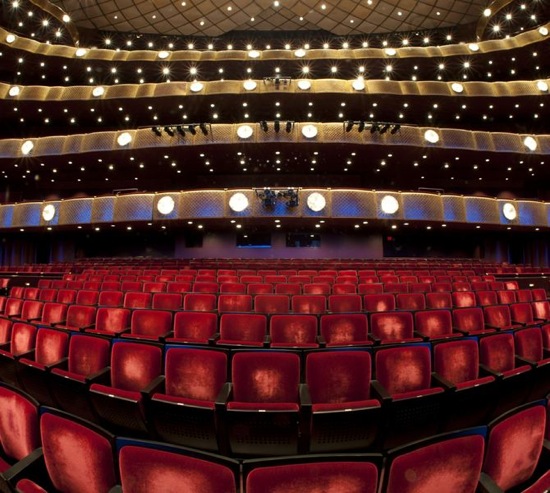
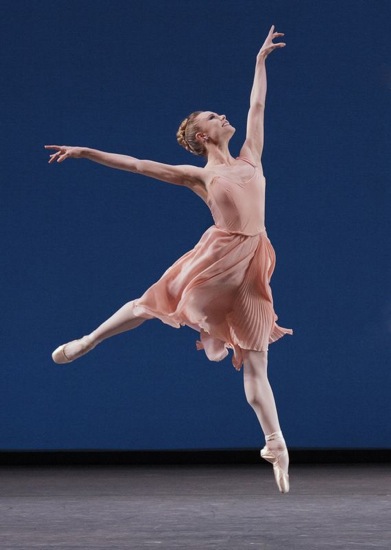
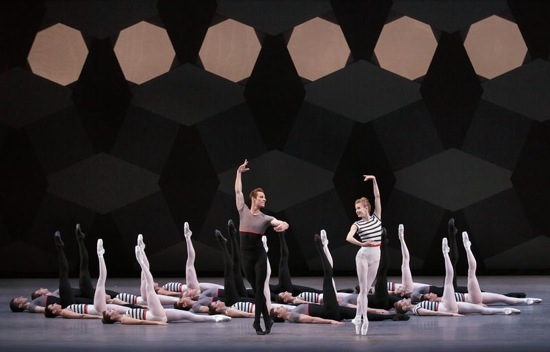
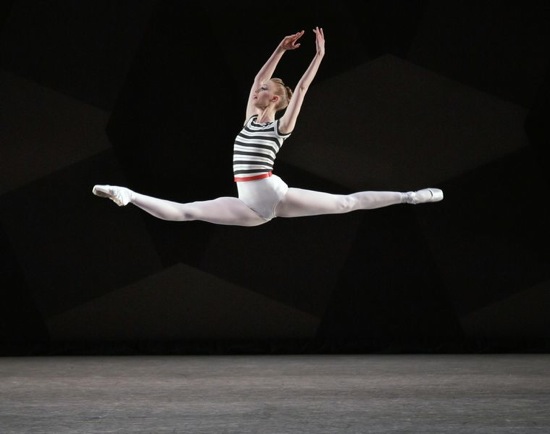
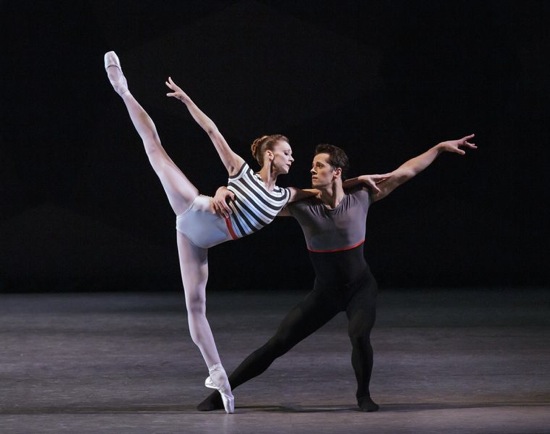
I’m glad to read your description of Peck’s work — we’re getting something from him here in Seattle next year, and I’m wondering what to expect.
I will be there at May 31. hope it will be fantastic, as a price for a ticket is fantastic 🙂
I am reminded by Deborah’s comments on Ballet Imperial that Balanchine made this ballet for the American Ballet Caravan 1941 tour of South America for two reasons: as a vehicle for Marie Jeanne, who Todd Bolender, who was on the tour, told me could toss off entrechat-huits in nothing flat, and to prove that American dancers could perform Russian ballet. Like my Seattle colleague, I am grateful for the description of Justin Peck’s work and look forward to seeing it.
A minor point –
Seeing how worn they look already, one would think those are the old seats, but alas they are not. The original seats were upholstered all around. The dead give-away is that one can see the new orchestra level aisles at the far edges of the photo.